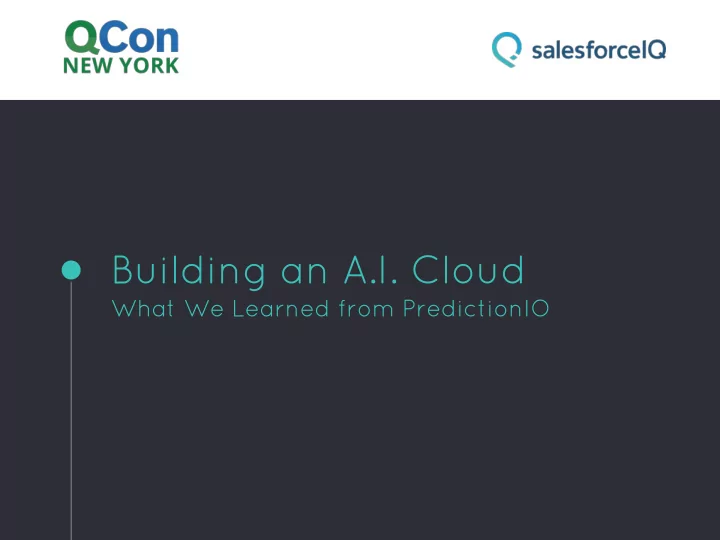

Building an A.I. Cloud What We Learned from PredictionIO
Simon Chan Sr. Director, Product Management, Salesforce Co-founder, PredictionIO PhD, University College London simon@salesforce.com
The A.I. Developer Platform Dilemma Simple Flexible
“ Every prediction problem is unique.
3 Approaches to Customize Prediction Custom Automation GUI Code & Script Simple Flexible
10 KEY STEPS to build-your-own A.I. P.S. Choices = Complexity
One platform, build multiple apps. Here are 3 examples. 1. E-Commerce 2. Subscription 3. Social Network Recommend Predict churn Detect spam products
Let’s Go Beyond Textbook Tutorial // Example from Spark ML website import org.apache.spark.ml.classification.LogisticRegression // Load training data val training = sqlCtx.read.format("libsvm").load("data/mllib/sample_libsvm_data.txt") val lr = new LogisticRegression ().setMaxIter(10).setRegParam(0.3).setElasticNetParam(0.8) // Fit the model val lrModel = lr.fit(training)
1 Define the Prediction Problem Be clear about the goal
Define the Prediction Problem Basic Ideas: ◦ What is the Business Goal? Better user experience ▫ ▫ Maximize revenue ▫ Automate a manual task ▫ Forecast future events ◦ What’s the input query? ◦ What’s the prediction output? ◦ What is a good prediction? ◦ What is a bad prediction?
2 Decide on the Presentation It’s (still) all about human perception
Decide on the Presentation Mailing List and Social Network, for example, may tolerate false predictions differently Actual NOT SPAM SPAM NOT SPAM True Negative False Negative Predicted SPAM False Positive True Positive
Decide on the Presentation Some UX/UI Choices: ◦ Toleration to Bad Prediction? ◦ Suggestive or Decisive? ◦ Prediction Explainability? ◦ Intelligence Visualization? ◦ Human Interactive? ◦ Score; Ranking; Comparison; Charts; Groups ◦ Feedback Interface ▫ Explicit or Implicit
3 Import Free-form Data Source Life is more complicated than MNIST and MovieLens datasets
Import Free-form Data Sources Some Types of Data: ◦ User Attributes ◦ Item (product/content) Attributes ◦ Activities / Events Estimate (guess) what you need.
Import Free-form Data Sources Some Ways to Transfer Data: ◦ Transactional versus Batch ◦ Batch Frequency ◦ Full data or Changed Delta Only Don’t forget continuous data sanity checking
Construct Features & Labels 4 from Data Make it algorithm-friendly!
Construct Features & Labels from Data Some Ways of Transformation: ◦ Qualitative to Numerical ◦ Normalize and Weight Aggregate - Sum, Average? ◦ ◦ Time Range ◦ Missing Records Label-specific: ◦ Delayed Feedback ◦ Implicit Assumptions Reliability of Explicit Opinion ◦ Different algorithms may need different things
Construct Features & Labels from Data Qualitative to Numerical // Example from Spark ML website - TF-IDF import org.apache.spark.ml.feature. { HashingTF , IDF , Tokenizer } val sentenceData = sqlContext.createDataFrame( Seq ( (0, "Hi I heard about Spark"), (0, "I wish Java could use case classes"), (1, "Logistic regression models are neat") )).toDF("label", "sentence") val tokenizer = new Tokenizer ().setInputCol("sentence").setOutputCol("words") val wordsData = tokenizer.transform(sentenceData) val hashingTF = new HashingTF () .setInputCol("words").setOutputCol("rawFeatures").setNumFeatures(20) val featurizedData = hashingTF.transform(wordsData) val idf = new IDF ().setInputCol("rawFeatures").setOutputCol("features") val idfModel = idf.fit(featurizedData) val rescaledData = idfModel.transform(featurizedData)
5 Set Evaluation Metrics Measure things that matter
Set Evaluation Metrics Some Challenges: ◦ How to Define an Offline Evaluation that Reflects Real Business Goal ? ◦ Delayed Feedback (again) ◦ How to Present The Results to Everyone ? ◦ How to Do Live A/B Test?
6 Clarify “Real-time” The same word can mean different things
Clarify “Real-time” Different Needs: ◦ Batch Model Update, Batch Queries ◦ Batch Model Update, Real-time Queries ◦ Real-time Model Update, Real-time Queries When to Train/Re-train for Batch?
7 Find the Right Model The “cool” modeling part - algorithms and hyperparameters
Find the Right Model Example of model hyperparameter selection // Example from Spark ML website // We use a ParamGridBuilder to construct a grid of parameters to search over. val paramGrid = new ParamGridBuilder () .addGrid(hashingTF.numFeatures, Array (10, 100, 1000)) .addGrid(lr.regParam, Array (0.1, 0.01)).build() // Note that the evaluator here is a BinaryClassificationEvaluator and its default metric // is areaUnderROC. val cv = new CrossValidator () .setEstimator(pipeline).setEvaluator( new BinaryClassificationEvaluator ) .setEstimatorParamMaps(paramGrid) .setNumFolds(2) // Use 3+ in practice // Run cross-validation, and choose the best set of parameters. val cvModel = cv.fit(training)
Find the Right Model Some Typical Challenges: ◦ Classification, Regression, Recommendation or Something Else? ◦ Overfitting / Underfitting ◦ Cold-Start (New Users/Items) ◦ Data Size ◦ Noise
8 Serve Predictions Time to Use the Result
Serve Predictions Some Approaches: ◦ Real-time Scoring ◦ Batch Scoring Real-time Business Logics/Filters is often added on top.
9 Collect Feedback for Improvement Machine Learning is all about “Learning”
Collect Feedback for Improvement Some Mechanism: ◦ Explicit User Feedback ▫ Allow users to correct, or express opinion on, prediction manually ◦ Implicit Feedback ▫ Learn from subsequence effects of the previous predictions ▫ Compare predicted results with the actual reality
10 Keep Monitoring & Be Crisis-Ready Make sure things are still working
Keep Monitoring & Be Crisis-Ready Some Ideas: ◦ Real-time Alert (email, slack, pagerduty) Daily Reports ◦ ◦ Possibly integrate with existing monitoring tools ◦ Ready for production rollback ◦ Version control For both prediction accuracy and production issues .
Summary: Processes We Need to Simplify Define the Prediction Problem Decide on the Presentation Import Free-form Data Sources Construct Features & Labels from Data Set Evaluation Metrics Clarify “Real-Time” Find the Right Model Serve Predictions Collect Feedback for Improvement Keep Monitoring & Be Crisis-Ready
The Future of A.I. is the automation of A.I.
Thanks! Any Questions? WE ARE HIRING. simon@salesforce.com @simonchannet
Recommend
More recommend